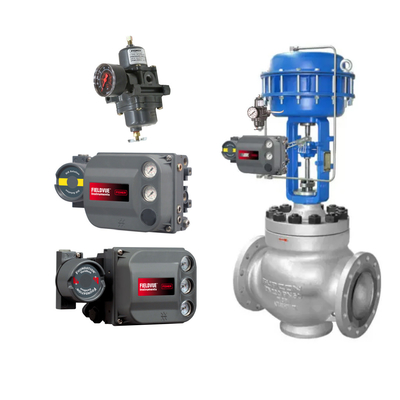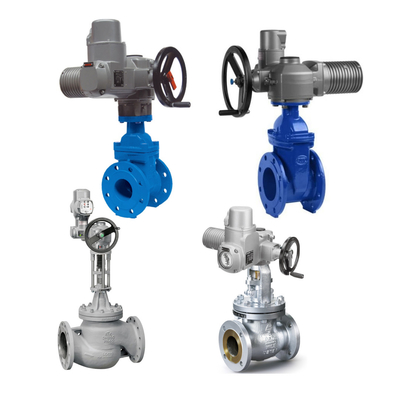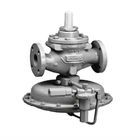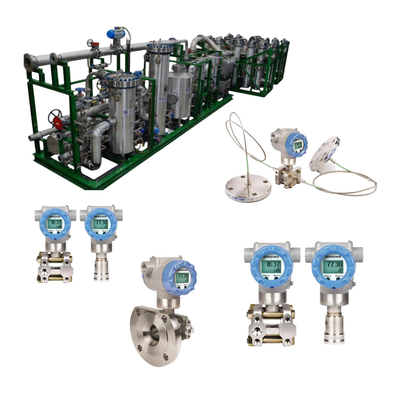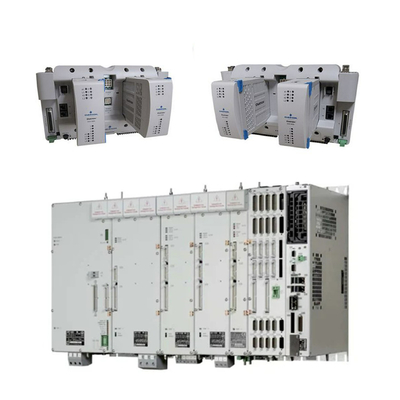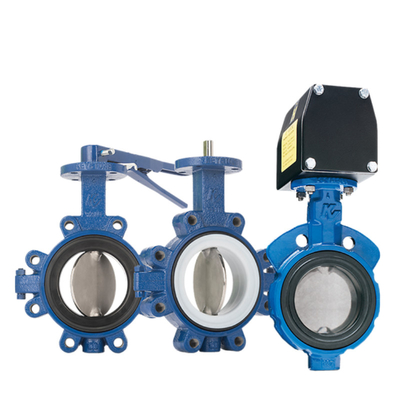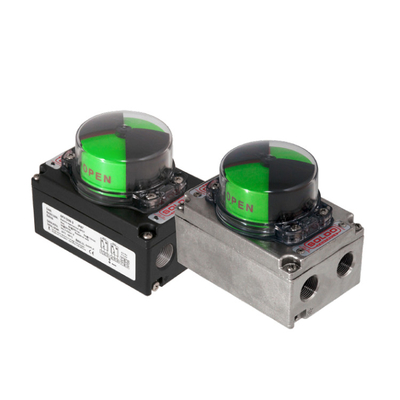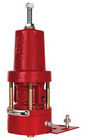Selectiehandleiding van de kleppositioners: diepgaande analyse- en applicatiestrategieën voor internationaal gerenommeerde merken
I. Inleiding
A. De kernrol van kleppositioners in industriële automatisering
In de complexe systemen van de moderne industriële productie worden regelkleppen algemeen erkend als de belangrijkste actuatoren voor het bereiken van procesautomatisering en het handhaven van processtabiliteit. Deze kleppen reguleren nauwkeurig kritische procesparameters zoals stroomsnelheid, druk, temperatuur en vloeistofniveau van vloeistoffen (inclusief gassen, stoom, water of verschillende chemische mengsels), waardoor productieprocessen soepel werken binnen vooraf gedefinieerde parameters.
Kleppositioners, als onmisbare accessoires voor regelkleppen, speel de rol van het "hersenen" in de gehele geautomatiseerde besturingslus. Hun kernfunctie is om opdrachtsignalen van het besturingssysteem te ontvangen en ze in realtime te vergelijken met de werkelijke positie van de klepsteel of klepas. Bij het detecteren van een afwijking past de positioner snel de luchtdruk of het elektrische signaal aan dat wordt geleverd aan de klepactuator om ervoor te zorgen dat de kleppositie nauwkeurig reageert op de vereisten van het besturingssysteem. Dit proces overwint effectief niet -lineaire kwesties zoals wrijving, vertraging en dode zones die regelkleppen kunnen tegenkomen tijdens de werking, waardoor een precieze controle en een snelle respons van de klep worden bereikt.
Van traditionele 'controle' tot moderne 'optimalisatie', de functionaliteit van kleppositioners ondergaat een belangrijke evolutie. Aanvankelijk werden positioners voornamelijk als gereedschap gezien om een precieze kleprespons op bedieningssignalen te garanderen, waarbij mechanische defecten inherent zijn aan kleppen, zoals het verpakken van wrijving en lag -fenomenen. Met de opkomst van Industry 4.0 en Smart Manufacturing heeft de rol van positioners echter de reikwijdte van eenvoudige kleppositie -controle veel overtroffen. Ze worden nu beschouwd als 'slimme activa' die in staat zijn om rijke realtime diagnostische gegevens te verstrekken en voorspellende onderhoudsanalyse uit te voeren, waardoor de niet-geplande downtime effectief wordt verminderd, het energieverbruik optimaliseert, de productkwaliteit aanzienlijk verbetert en uiteindelijk de operationele efficiëntie en winstgevendheid van de hele fabriek verbetert.
Deze functionele transformatie is het onvermijdelijke resultaat van verschillende geavanceerde technologische vooruitgang. De toepassing van niet-contact-positie feedback-technologieën zoals Hall Effect Sensors heeft bijvoorbeeld de nauwkeurigheid en betrouwbaarheid van positiemeting aanzienlijk verbeterd, terwijl de mechanische slijtage wordt verminderd. Bovendien heeft de integratie van ingebouwde microprocessors en geavanceerde besturingsalgoritmen positioners met krachtige gegevensverwerkingsmogelijkheden begiftigd. Bovendien stelt de wijdverbreide acceptatie van digitale communicatieprotocollen zoals HART, Foundation Fieldbus en PROFIBUS Positioners in staat om bidirectionele, snelle gegevensuitwisseling met controlesystemen aan te gaan. Deze technologieën werken samen om ervoor te zorgen dat kleppen niet alleen precies kunnen worden gecontroleerd, maar ook actief hun eigen gezondheidstoestand kunnen "rapporteren" en zelfs "voorspellen" potentiële mislukkingen.
Daarom gaat de selectie van kleppositioners niet langer alleen over het voldoen aan de vereisten voor basisstroomcontrole, maar is het geëvolueerd tot een strategische investering in de algehele efficiëntie, betrouwbaarheid en veiligheid van het productieproces. Intelligente positioners kunnen regelkleppen transformeren van passieve apparaten die opdrachten uitvoeren in actieve deelnemers in procesoptimalisatie en providers van kritieke gegevens, waardoor een solide basis wordt gelegd voor de digitale transformatie van een bedrijf.

B. Doel en structuur van dit rapport
Dit rapport is bedoeld om lezers een uitgebreide en diepgaande gids te bieden voor het selecteren van kleppositioners. Het rapport zal een diepgaande analyse uitvoeren van internationaal gerenommeerde merken zoals Fisher, Masoneilan, Flowserve, Samson en Neles, met details over hun respectieve productkenmerken, kerntechnologische voordelen, prijsstrategieën en gespecialiseerde toepassingsgebieden in verschillende industrieën.
Het rapport zal eerst beginnen met de basiswerkprincipes en de belangrijkste soorten kleppositioners, het analyseren van de voor- en nadelen van verschillende soorten positioners en hun toepasselijke scenario's. Vervolgens zal het rapport ingaan op de belangrijkste factoren om te overwegen bij het selecteren van een kleppositioner, inclusief prestaties en precisievereisten, operationele omgeving en veiligheidsoverwegingen, compatibiliteit en integratie met controlesystemen en kosten-batenanalyse. Na het uitvoeren van een uitgebreide analyse van verschillende internationaal gerenommeerde merken, biedt het rapport specifieke selectiestrategieën om lezers te begeleiden bij het nemen van de meest geschikte merk- en modelbeslissingen op basis van hun procesvereisten, operationele omgevingen en budgetbeperkingen. Ten slotte zal het rapport Xiangjing Company en zijn bijdragen aan de klepindustrie introduceren.
II. Klep Positioner Basics: Werkprincipes en -typen
A. Wat is een kleppositieer?
1. Definitie en basisfuncties
Een kleppositioner is een precisiebewegingscontroleapparaat waarvan de kernfunctie is om ervoor te zorgen dat de actuator van een regelklep de klepstam of klepas nauwkeurig kan positioneren op het setpoint dat vereist is door het besturingssysteem. Het ontvangt continu commandosignalen (dwz setpoints) van het besturingssysteem en vergelijkt ze in realtime en met hoge precisie met de werkelijke positie van de klepstam of klepas (dwz feedbacksignalen). Zodra elke afwijking tussen de twee is gedetecteerd, past de positioner onmiddellijk de luchtdruk of het elektrische signaal aan dat wordt geleverd aan de klepactuator totdat de klep precies de gewenste positie bereikt.
Deze kernfunctie van de positioner is ontworpen om verschillende factoren te overwinnen die de precieze positionering van de klep kunnen beïnvloeden. Deze factoren omvatten wrijving veroorzaakt door klepstamverpakking, inherente hysterese in de actuator en onevenwichtige krachten gegenereerd door de klepstekker onder vloeistofdruk. Door deze storingen actief te compenseren, zorgt de positioner ervoor dat de regelklep op betrouwbare wijze, nauwkeurig en snel kan reageren op controlesignalen, waardoor stabiele procesparameters worden gehandhaafd. In termen van fysieke installatie wordt de positioner meestal ingenieus gemonteerd op het juk of de bovenste behuizing van de actuator. Het maakt verbinding met de klepstam of klepas via mechanische koppelingen of meer geavanceerde niet-contact sensoren, waardoor realtime acquisitie van precieze positiefeedback van de klep mogelijk is.
2. Belang in de controlelus
In moderne fabrieken, waar netwerken van honderden of duizenden complexe controlelussen worden geïmplementeerd, dienen regelkleppen als de uiteindelijke besturingselementen die kritische procesvariabelen reguleren, zoals vloeistofstroom, druk, niveau en temperatuur. Deze besturingslussen zijn ontworpen om ervoor te zorgen dat alle belangrijke procesvariabelen binnen het vereiste werkbereik blijven, waardoor de productkwaliteit en processtabiliteit worden garandeerd.
Kleppositioners verminderen de procesvariabiliteit aanzienlijk, verbeteren de productkwaliteit en zorgen voor systeemstabiliteit in het licht van interne en externe storingen (zoals belastingveranderingen) door nauwkeurige kleppositiecontrole te bieden. In wezen functioneert het als een "ingebed besturingssysteem", met behulp van het uitgangssignaal van de hoofdprocescontroller als het setpoint en het nauwkeurig aanpassen van de druk van de actuator op basis van de werkelijke positie feedback van de klep. Deze cascade -structuur van het besturingssysteem stelt de klep in staat om meer precieze en snelle reacties te bereiken, waardoor de prestaties van de gehele besturingslus worden verbeterd.
Kleppositioners spelen een cruciale rol bij het aanpakken van de "laatste mijl" -besturingsuitdagingen in procescontrole. Hoewel de controller signalen uitgeeft, kan de klepactuator zelf inherente kwesties hebben zoals niet -lineariteit, wrijving en dode zones, wat leidt tot afwijkingen tussen de werkelijke kleppositie en de gewenste positie van de controller. Dit fenomeen beïnvloedt de nauwkeurigheid van de controle en de systeemstabiliteit. De positioner overbrugt deze "kloof" tussen de controller en de klepactuator via zijn interne realtime feedback en lokale aanpassingsmechanismen, zodat controlesignalen nauwkeurig worden omgezet in fysieke acties van de klep. Dit is verwant aan een precisie-servosysteem, waarbij de besturingsopdrachten op macroniveau worden vertaald in een nauwkeurige uitvoering op microniveau.
Zonder een positioner, wanneer de controller rechtstreeks de actuator aandrijft, vanwege de inherente mechanische kenmerken van de actuator (zoals wrijving door klepstamverpakking of actuatorvertraging), kan de klep niet nauwkeurig de gespecificeerde positie bereiken of ervaring aanzienlijk de responstijden aanzienlijk vertraagden. De positioner, via zijn interne feedback-lus en high-gain versterker, drijft de klep actief en krachtig naar de gespecificeerde positie, zelfs in aanwezigheid van externe storingen zoals onevenwichtige krachten veroorzaakt door veranderingen in vloeistofdruk. Deze mogelijkheid verbetert direct de algehele prestaties en stabiliteit van de besturingslus, zodat de procesvariabele zo dicht mogelijk bij het setpoint blijft.
Daarom dient de positioner als de 'laatste mijl' -precisiebezit in procescontrole. Vooral in toepassingen waarvoor throttling -regulering vereist, zorgt het voor een precieze controle van de vloeistofstroom, wat van cruciaal belang is voor het handhaven van de productkwaliteit, het optimaliseren van het energieverbruik en het waarborgen van procesveiligheid. Door deze hoog-nauwkeurige kleppositiecontrole te bieden, stelt de positioner het hele processysteem stabieler en efficiënter in staat.
B. Belangrijkste soorten kleppositioners
Kleppositioners zijn voornamelijk gecategoriseerd in drie hoofdtypen op basis van hun bedrijfsprincipes en de signaaltypen die ze gebruiken: pneumatische positioners, elektro-pneumatische (I/P) -positioners en digitale (slimme) positers. Elk type heeft zijn unieke bedrijfsmechanismen, voor- en nadelen, evenals toepasselijke industriële scenario's.
1. Pneumatische positioners
Pneumatische positioners zijn het meest traditionele en langst bestaande type kleppositioners, met hun werking volledig afhankelijk van gecomprimeerde lucht als het medium voor signaaltransmissie en vermogensuitvoering.
A. Werkprincipe en kenmerken:
Pneumatische positioners ontvangen pneumatische ingangssignalen van besturingsapparaten, die meestal tot expressie worden gebracht in standaard drukbereiken zoals 3-15 psi (0,2-1,0 bar) of 6-30 psi (0,4-2,0 bar). Hun interne werking is gebaseerd op het principe van krachtbalans, zoals het klassieke mondstuk-/openingsplaatsysteem. Wanneer de ingangssignaaldruk verandert, werken een reeks mechanische hefbomen en balg op om de opening tussen het mondstuk en de plaat aan te passen, waardoor de luchtdruk wordt geleverd aan de regelaar van de regelklep. Deze verordening maakt de positie van de klepsteel of klepas mogelijk om het ingangssignaal nauwkeurig op een evenredige manier te matchen.
B. Voordelen en nadelen analyse:
Voordelen:
- Eenvoudige structuur en eenvoudig onderhoud: pneumatische apparaten zijn meestal eenvoudig in structuur, lichtgewicht en relatief eenvoudig te installeren en te onderhouden.
- Milieuvriendelijk en kosteneffectief: het werkmedium is lucht, wat gemakkelijk uit te putten is en het milieu niet vervuilt, en de lucht zelf is goedkoop.
- Intrinsieke explosieve bestendige kenmerken: aangezien er geen elektrische componenten of vonken bij betrokken zijn, hebben pneumatische positioners intrinsieke explosiepeilige kenmerken, waardoor ze zeer geschikt zijn voor gevaarlijke omgevingen zoals olie, aardgas en chemische industrieën waar brandbare en explosieve stoffen aanwezig zijn.
- Hoge betrouwbaarheid en lange levensduur: pneumatische componenten kunnen miljoenen effectieve operationele cycli weerstaan, die doorgaans een hoge betrouwbaarheid en een lange levensduur bieden.
- Fail-Safe-werking: bij gebruik met actuatoren voor de veerrichting bieden pneumatische positioners een betrouwbare faalveilige werking in het geval van storing in de luchttoevoer, waardoor de klep naar een vooraf ingestelde veilige positie wordt gebracht (volledig open of volledig gesloten).
Nadelen:
- Beïnvloed door belastingwijzigingen: vanwege de samendrukbaarheid van lucht, wordt de besturingssnelheid van cilinders gemakkelijk beïnvloed door belastingveranderingen, wat kan leiden tot verminderde controle -nauwkeurigheid.
- Onvoldoende stabiliteit met lage snelheid: tijdens lage snelheidsbeweging, vanwege het relatief hoge aandeel wrijvingskracht in de stuwkracht, is de lage snelheidsstabiliteit van cilinders inferieur aan die van hydraulische cilinders.
- Beperkte uitgangskracht: hoewel de uitgangskracht van cilinders in veel toepassingen kan voldoen aan de vereisten, is deze over het algemeen lager dan die van hydraulische cilinders en is deze niet geschikt voor zware taken.
- Langzame signaaltransmissiesnelheid: de transmissiesnelheid van pneumatische signalen is aanzienlijk langzamer dan die van elektrische signalen, met significante vertragingen en vervormingen, waardoor ze ongeschikt zijn voor complexe besturingssystemen die een snelle signaaltransmissie vereisen.
- Hoge vereisten voor de luchtkwaliteit van instrument: om een stabiele werking op de lange termijn te garanderen, hebben pneumatische positioners strikte vereisten voor de kwaliteit van het instrumentluchttoevoer, waarvoor schone, droge, olievrije perslucht nodig is om verontreiniging en slijtage van interne precisiecomponenten te voorkomen.
2. Electro-pneumatische (I/P) -positioners
Elektro-pneumatische positioners zijn een veel gebruikt type in de moderne industrie, waardoor de voordelen van elektrische signaaltransmissie effectief worden gecombineerd met de vermogenskenmerken van pneumatische actuatoren.
A. Werkprincipe en functies:
Elektro-pneumatische positioners ontvangen elektrische signalen van het besturingssysteem, meestal standaard 4-20 mA DC-stroomsignalen of 0-10V DC-spanningssignalen. Hun kerncomponent is de I/P (huidige-pneumatische) converter, die de ontvangen elektrische signalen nauwkeurig omzet in proportionele pneumatische druksignalen. Deze pneumatische signalen worden vervolgens overgebracht naar het pneumatische gedeelte van de positioner, waardoor de klepactuator wordt gedreven om een precieze kleppositieregulatie te bereiken. Dit ontwerp stelt elektro-pneumatische positioners in staat om te dienen als een brug tussen elektrische signaalbesturingssystemen en pneumatische actuatoren.
B. Voordelen en nadelen analyse:
Voordelen:
- Hoge compatibiliteit: het kan direct elektrische signalen verwerken en heeft een goede compatibiliteit met modern DCS (gedistribueerd besturingssysteem) en PLC -systemen (programmeerbare logische controller), waardoor het gemakkelijk te integreren is in bestaande besturingsarchitecturen.
- Verbeterde nauwkeurigheid en resolutie: vergeleken met zuivere pneumatische positioners bieden elektro-pneumatische positioners meestal een hogere nauwkeurigheid en resolutie, waardoor een precieze kleppositiecontrole mogelijk is.
- Sterke interferentieweerstand: elektrische signalen hebben een sterkere weerstand tegen elektromagnetische interferentie tijdens overdracht op lange afstand en zijn minder vatbaar voor verzwakking, waardoor signaalintegriteit en betrouwbaarheid wordt gewaarborgd.
Nadelen:
- Ontwerpcomplexiteit: vergeleken met puur pneumatische positioners hebben elektro-pneumatische positioners complexere ontwerpen en structuren, met zowel elektrische als pneumatische componenten.
- Hogere kosten: vanwege hun complexiteit en ingebouwde I/P-converters kosten elektro-pneumatische positioners meestal meer dan puur pneumatische positioners.
- Overwegingen van I/P Converter Installatie: hoewel I/P-converters in positioners kunnen worden ingebouwd, kunnen sommige productiefaciliteiten de voorkeur geven aan I/P-converters op afstand te installeren vanwege problemen zoals trillingen op locatie, temperatuurschommelingen of ruimtebeperkingen, die de bedrading en installatiecomplexiteit verhogen.
3. Digitale (slimme) positioners
Digitale (slimme) positioners vertegenwoordigen de nieuwste ontwikkeling in kleppositioner -technologie. Het zijn geavanceerde instrumenten op basis van microprocessors en bieden ongekende controle -nauwkeurigheid, diagnostische mogelijkheden en communicatiefuncties.
A. Werkprincipe en functies:
Digitale positioners ontvangen digitale elektrische signalen, zoals HART-protocol, foundation fieldbus of Profibus PA-Fun digitale communicatieprotocollen gesuperponeerd op een 4-20MA analoog signaal. Hun kern ligt in de ingebouwde microprocessor, die kleppositie-regeling uitvoert door middel van complexe digitale algoritmen, ter vervanging van de mechanische koppelingen, nokken of mondstuk/flap-assemblages gevonden in traditionele pneumatische en elektrische actuatoren. Bovendien gebruiken digitale positioners meestal geen contact, link-vrije positie feedback-technologie, zoals Hall Effect-sensoren, om de positie van de klepstaal te meten. Dit ontwerp elimineert fundamenteel de impact van mechanische slijtage, losraken, corrosie en trillingen op de prestaties, waardoor de productbetrouwbaarheid en de levensduur van het services aanzienlijk wordt verbeterd.
B. Voordelen en nadelen analyse:
Voordelen:
- Extreem hoge precisie en resolutie: digitale positioners bereiken extreem hoge positioneringsprecisie en resolutie, ter ondersteuning van complexe bewegingspatronen en hoogcisiepositioneringstaken om de nauwkeurigheid van vloeistofcontrole te waarborgen. Vooral Hall Effect Sensor Technology maakt contactloze nauwkeurige metingen mogelijk, waardoor de algehele precisie aanzienlijk wordt verbeterd.
- Robuuste diagnostische en communicatiemogelijkheden: dit is een kernvoordeel van digitale positioners. Ze hebben uitgebreide diagnostische functies, waardoor online monitoring, foutdiagnose, voorspellend onderhoud en ondersteuning voor externe configuratie en kalibratie mogelijk wordt. Dit helpt bij het verlagen van ongeplande downtime en onderhoudskosten.
- Lage onderhoudsbehoeften en lange levensduur: vanwege minder componenten en geen betrokkenheid bij vloeistofsystemen (zoals hydraulische of pneumatische actuatoren), hebben elektrische lineaire actuatoren (actuatoren) extreem onderhoudsarme vereisten. Digitale positioners hebben de operationele levensduur aanzienlijk verlengd vanwege de afwezigheid van mechanische slijtage en geavanceerde zelfdiagnostische mogelijkheden.
- Laag energieverbruik: vergeleken met hydraulische of pneumatische actuatoren verbruiken elektrische actuatoren minder energie in statische belastingtoepassingen. Na kleppositionering is het steady-state luchtverbruik van digitale positioners te verwaarlozen, waardoor het energieverbruik aanzienlijk wordt verminderd.
Nadeel:
- Hoogste kosten: digitale positioners hebben doorgaans de hoogste initiële inkoopkosten bij alle soorten.
- Complexiteit van het besturingssysteem: hun besturingssystemen zijn complexer en vereisen gespecialiseerde kennis en vaardigheden voor installatie, inbedrijfstelling en onderhoud.
- Overwegingen van explosieverdichte certificering: hoewel veel digitale positioners explosiebestendige certificering hebben, kan aanvullende certificering of speciaal ontwerp vereist zijn onder extreme explosiebestendige vereisten om een veilige werking in explosieve omgevingen te garanderen.

Fisher 3620J
C. Vergelijking van toepassingsscenario's voor verschillende soorten positioners
De evolutie van kleppositioners van puur pneumatisch tot elektrisch geëxploiteerd en vervolgens tot digitale intelligente systemen weerspiegelt duidelijk het voortdurende streven naar "precisie, efficiëntie en connectiviteit" in het industriële controleveld. Deze technologische vooruitgang is geen eenvoudige vervangingsrelatie, maar eerder een coëxistentie en ontwikkeling op basis van verschillende toepassingsvereisten en kosteneffectiviteit.
Puur pneumatische positioners, met hun inherente explosiebestendige kenmerken, eenvoudige structuur en goedkope voordelen, hebben nog steeds een unieke waarde en toepasbaarheid in bepaalde gevaarlijke gebieden waar precisievereisten relatief laag zijn, zoals eenvoudige aan/uit-controle of kostengevoelige toepassingen. Ze blijven een betrouwbare en economische keuze in omgevingen waar stroom niet beschikbaar is of vonkrisico's hoog zijn.
Electropneumatische positioners dienen als een brug tussen traditionele analoge signalen en pneumatische actuatoren, die de reguliere keuze blijven in veel bestaande industriële controlesystemen. Ze combineren de transmissievoordelen van elektrische signalen (zoals interferentieweerstand op lange afstand) met de vermogenskenmerken van pneumatische actuatoren, waardoor ze geschikt zijn voor industriële instellingen die een hoge precisie en elektrische signaalregeling vereisen. Dit type is een natuurlijke keuze voor het upgraden of achteraf van traditionele DCS -systemen, omdat het de besturingsprestaties verbetert zonder de bestaande architectuur volledig te wijzigen.
Digitale positioners vertegenwoordigen de toekomstige trend in kleppositioner -technologie. Hun robuuste diagnostische en communicatiemogelijkheden maken hen tot een belangrijke technologie voor het bereiken van industrie 4.0 en voorspellend onderhoud. Via ingebouwde microprocessors en niet-contact feedback-technologie bieden digitale positioners uitzonderlijke precisie en uitgebreide klepgezondheidsinformatie, waardoor "condition-gebaseerd onderhoud" en "voorspellend onderhoud" mogelijk is. Dit betekent dat bedrijven onderhoud kunnen plannen op basis van de werkelijke bedrijfstoestand van de apparatuur in plaats van een vast schema, waardoor downtime wordt geminimaliseerd en onderhoudsmiddelen wordt geoptimaliseerd.
Deze evolutie is geen eenvoudige vervanging, maar eerder een gevolg van een diep begrip van verschillende toepassingsvereisten en een balans van kosteneffectiviteit. Pneumatische positioners, met hun "eenvoudige goedkope" en "intrinsiek explosieverdichte" kenmerken, hebben nog steeds een markt in eenvoudige toepassingen waar stroom niet beschikbaar is of er een hoog risico op vonken is. Elektro-pneumatische positioners gaan via I/P-converters de uitdaging aan om de voordelen van langeafstandsoverdracht van elektrische signalen te combineren met pneumatische actuatoren, waardoor ze een natuurlijke keuze zijn voor het upgraden van traditionele DCS-systemen. Digitale positioners, uitgerust met microprocessors en contactloze feedback, hebben aanzienlijk verbeterde precisie- en diagnostische mogelijkheden, waardoor "conditiebasis onderhoud" en "voorspellend onderhoud" mogelijk is. Deze functionele expansie transformeert kleppositioners van eenvoudige actuatoren in intelligente apparaten die in staat zijn om kritische operationele gegevens te verstrekken.
Daarom moeten bedrijven bij het selecteren van een positioner de voordelen van technologische vooruitgang (zoals verminderde downtime, verbeterde productkwaliteit en geoptimaliseerd energieverbruik) in evenwicht brengen tegen initiële investeringen en onderhoudscomplexiteit. Voor niet-kritische aan/uit-kleppen kan een eenvoudige pneumatische positioner bijvoorbeeld voldoende zijn; Voor hoogwaardige, risicovolle gejaagde lussen, is de extra investering in een digitale intelligente positioner echter de moeite waard, omdat het de processtabiliteit, veiligheid en economische efficiëntie aanzienlijk verbetert. Besluitvormers mogen niet blindelings de hoogste technologie nastreven, maar een uitgebreide levenscycluskostenanalyse uitvoeren, rekening houdend met initiële inkoop, installatie, operationeel energieverbruik, onderhoudskosten, evenals potentiële productieverliezen en veiligheidsrisico's.
De onderstaande tabel biedt een uitgebreide vergelijking van verschillende soorten kleppositioners om lezers te helpen hun respectieve kenmerken en toepassingsbereiken beter te begrijpen:
Tabel 1: Vergelijking van kleppositionerstypen
| Positioner type |
Werkprincipe |
Voordelen |
Nadelen |
Typische toepassingen |
| Pneumatische positioner |
Zuiver pneumatisch signaal, krachtbalansprincipe, reguleert de luchtbrondruk om de actuator aan te sturen |
Eenvoudige structuur, goedkope, inherent explosiebestendige, hoge betrouwbaarheid, eenvoudig onderhoud |
Gevoelig voor belastingseffecten, slechte stabiliteit met lage snelheid, beperkte uitgangskracht, langzame signaaltransmissie, hoge vereisten voor luchtbronkwaliteit |
Eenvoudige aan/uit-controle, gevaarlijke omgevingen, kostengevoelige toepassingen |
| Elektro-pneumatische (I/P) positioner |
Elektrisch signaal (4-20 mA) omgezet in pneumatisch signaal via I/P-omzetter voor pneumatische regeling |
Compatibel met elektrische signalen, hogere precisie en resolutie, sterke interferentieweerstand |
Complexe structuur, hogere kosten, I/P -converter kan installatie op afstand vereisen |
Traditionele DCS/PLC -systemen, industriële instellingen die een hoge precisie en elektrische signaalregeling vereisen |
| Digitale (slimme) positioner |
Microprocessor verwerkt digitale signalen, contactloze feedback, geavanceerde algoritmebestrijding |
Extreem hoge precisie, geavanceerde diagnostiek, afstandsbediening, weinig onderhoud, lage energieverbruik, lange levensduur |
Hoogste kosten, complex besturingssysteem, installatie en onderhoud vereisen professionele kennis |
Processen met een hoog nauwkeurige, automatisering, data-acquisitie, IoT, voorspellend onderhoud |

Fisher DPC2K
Iii. Belangrijkste overwegingen voor het selecteren van een kleppositioner
Het selecteren van de juiste kleppositioner is een multidimensionaal, systematisch besluitvormingsproces dat een uitgebreide overweging van meerdere belangrijke factoren vereist, waaronder prestatievereisten, bedrijfsomgeving, systeemcompatibiliteit en kosteneffectiviteit.
A. Prestaties en precisievereisten
De prestaties van een kleppositioner bepaalt direct de precisie en stabiliteit van de controlelus. Daarom zijn prestaties en precisievereisten de primaire overwegingen tijdens de selectie.
1. Positioneringsnauwkeurigheid en herhaalbaarheid
De positioneringsnauwkeurigheid verwijst naar de mate van nabijheid tussen de werkelijke positie van de klep en de gewenste positie, terwijl herhaalbaarheid verwijst naar het vermogen van de klep om elke keer onder hetzelfde signaal dezelfde positie te bereiken. Nauwkeurige en herhaalbare positionering is een kernvoordeel van elektrische lineaire actuatoren (als onderdeel van het actuatorsysteem) en digitale positioners. Digitale positioners, uitgerust met ingebouwde microprocessors en geavanceerde besturingsalgoritmen, kunnen een hogere positioneringsnauwkeurigheid en lagere foutenpercentages bereiken dan traditionele positioners. Bijvoorbeeld, zonder contact feedback-technologieën zoals Hall Effect-sensoren maken een precieze metingen mogelijk zonder fysiek contact, waardoor de algehele controle-nauwkeurigheid en betrouwbaarheid aanzienlijk wordt verbeterd.
2. Reactiesnelheid en stabiliteit
De responssnelheid verwijst naar de tijd die de klep is om zijn nieuwe positie te bereiken na ontvangst van het besturingssignaal. Positioners kunnen de responssnelheid van de klep aanzienlijk versnellen en de responstijd verkorten door een hogere luchtstroom en druk te bieden. Dit is van cruciaal belang voor systemen die snelle aanpassingen vereisen om te reageren op procesveranderingen, zoals bij snel veranderende stroom- of drukregellussen. Bovendien, door de kleppositie continu te bewaken en aan te passen, helpt de positioner effectief de processtabiliteit te behouden, oscillaties of schommelingen te onderdrukken en ervoor te zorgen dat procesvariabelen soepel in de buurt van het setpoint werken.
3. Eliminatie van hysterese en deadband
Hysterese verwijst naar het fenomeen waarbij de uitgangsrespons van de klep achterblijft bij de invoerverandering wanneer de richting van de ingangssignaal verandert; Deadband verwijst naar het bereik waarbinnen de klepuitgang niet reageert op veranderingen in het ingangssignaal. Deze niet -lineaire kenmerken verminderen de nauwkeurigheid van de controle. Positioners kunnen hysterese en deadband veroorzaakt door klepsteelpakkingwrijving effectief compenseren en elimineren, zodat de klep precies en gevoelig reageert om signalen over het gehele reisbereik te regelen. Dit is van cruciaal belang voor het bereiken van een zeer nauwkeurige regelgeving en het vermijden van procesafwijkingen, vooral in de toepassingen van throttlingcontrole die frequente kleine aanpassingen vereisen.
Bij het selecteren van een kleppositioner is er een belangrijk saldo tussen precisie en kosten. Hoewel digitale positioners een uitzonderlijke positioneringsnauwkeurigheid en robuuste diagnostische mogelijkheden bieden, zijn hun initiële inkoopkosten doorgaans hoger. Niet alle industriële applicaties kunnen zich een dergelijke hoge initiële investering veroorloven of vereisen. Voor toepassingen met relatief minder strenge precisievereisten maar kostengevoeligheid, kunnen pneumatische of elektromechanische positioners een betere kosteneffectiviteit bieden. Deze keuze is een afweging die moet worden bepaald op basis van de precisievereisten van het specifieke proces, de potentiële verliezen door niet-geplande downtime en beschikbare budgetbeperkingen.
Hoge precisie wordt vaak geleverd met meer complexe detectietechnologie (bijv. Niet-Contact Hall Effect-sensoren), krachtigere gegevensverwerkingsmogelijkheden (bijv. Ingebouwde microprocessors) en meer precieze productieprocessen, die allemaal direct bijdragen aan hogere productiekosten. In bepaalde hoogwaardige, hoog risico- of kwaliteitskritische processen kunnen de voordelen van verbeterde controleprecisie echter veel opwegen tegen de initiële investering. In de Fine Chemicals-industrie kan precieze stroomcontrole bijvoorbeeld dure zijreacties of productschroot effectief voorkomen, waardoor de waarde van positioners met een hoge precisie wordt rechtvaardigen.
Daarom moeten besluitvormers niet blindelings de hoogste technologie nastreven, maar een uitgebreide analyse van Life Cycle Cost (LCC) uitvoeren. Deze analyse moet rekening houden met alle relevante factoren, inclusief initiële inkoopkosten, installatie- en inbedrijfstellingskosten, dagelijkse operationele energieverbruik, onderhoudskosten, voorraadkosten voor reserveonderdelen en potentiële productieverliezen en veiligheidsrisico's veroorzaakt door fouten van apparatuur. Door deze uitgebreide beoordeling kunnen bedrijven vaststellen welke aanvullende investeringen in precisie en functionaliteit de grootste langetermijnrendementen zullen opleveren in specifieke toepassingsscenario's.
B. Bedrijfsomgeving en veiligheidsoverwegingen
Kleppositioners worden meestal geconfronteerd met harde operationele omgevingen in industriële omgevingen, en veiligheidsprestaties zijn een fundamentele vereiste voor industriële apparatuur. Daarom is het bij het selecteren van een kleppositioner essentieel om een uitgebreide beoordeling van de operationele omgeving en veiligheidseisen uit te voeren.
1. Aanpassingsvermogen van het milieu (temperatuur, trillingen, corrosie)
Kleppositioners moeten in staat zijn tot een langdurige stabiele werking in verschillende harde industriële omgevingen, waaronder extreme temperaturen (zowel hoog als laag), hoge mechanische trillingen en omgevingen met corrosieve gassen. Fabrikanten investeren aanzienlijke R & D -inspanningen om robuuste en duurzame producten te ontwerpen. Gemeenschappelijke oplossingen omvatten het gebruik van volledig afgesloten elektronische componenten om het binnendringen van vocht en stof binnen te stappen, het gebruik van corrosiebestendige materialen (zoals roestvrijstalen stalen behuizingen) om corrosieve media te weerstaan, en het aanbieden van opties met brede temperatuurbereik (bijvoorbeeld bepaalde modellen ondersteunen extreme temperaturen van -55 ° C tot +85 ° C). Bovendien hebben sommige geavanceerde positioners superieure trillingsbestendige ontwerpen, zoals het Rodless, niet-contacte positie feedbacksysteem van de Fisher DVC6200, die effectief mechanische slijtage elimineert, wat resulteert in een hogere betrouwbaarheid in trillende en corrosieve omgevingen. Het brede temperatuurbereik van de Masoneilan SVI3 en ingekapselde elektronische componenten demonstreren ook zijn aanpassingsvermogen aan barre omgevingen.
De complexiteit van industriële omgevingen legt strenge vereisten op aan het positionerontwerp. Fabrikanten verbeteren het aanpassingsvermogen van het milieu door vooruitgang in materiaalwetenschappen, geavanceerde verpakkingstechnologieën en structurele optimalisatie. Barme omgevingen kunnen slijtage, corrosie en falen van traditionele mechanische componenten veroorzaken. Om betrouwbaarheid op de lange termijn te garanderen, moeten fabrikanten duurzamer materiaal, meer verzegelde verpakkingen en meer trillingsbestendige structuren ontwikkelen. Bijvoorbeeld, Magnetic Hall Effect -sensoren behandelen fundamenteel mechanische slijtageproblemen door fysiek contact te voorkomen, waardoor de betrouwbaarheid in harde omgevingen wordt verbeterd.
Milieuaanpassingsvermogen heeft direct invloed op de levenscycluskosten van apparatuur en de operationele veiligheid van de plant. Bij het selecteren van een positioner moet men zich niet alleen concentreren op de besturingsprestaties, maar ook de betrouwbaarheid op lange termijn in specifieke bedrijfsomgevingen beoordelen. Hoewel producten met een superieure aanpassingsvermogen van het milieu hogere initiële beleggingskosten met zich meebrengen, kunnen ze de onderhoudskosten en het risico op niet -geplande downtime veroorzaakt door omgevingsfactoren aanzienlijk verlagen, waardoor grotere algemene voordelen voor bedrijven opleveren.
2. Fail-safe modi
Fail-safe is een cruciaal kenmerk van regelkleppen en hun actuatoren, verwijzend naar de automatische beweging van het stroomcontrolelement van de klep naar een vooraf bepaalde positie wanneer de aandrijfsenergie (zoals instrumentlucht of voeding) wordt onderbroken, waardoor de veiligheid van het proces en apparatuur wordt beschermd. Gemeenschappelijke faalveilige modi op basis van procesveiligheidsvereisten zijn onder meer:
- A.Fail-CLOSE (FC): Wanneer de drive-energie verloren gaat, beweegt het stroomherstelelement van de klep automatisch naar de gesloten positie. Deze modus wordt vaak gebruikt in scenario's waarbij de vloeistoftoevoer moet worden onderbroken om gevaarlijke situaties te voorkomen, zoals veiligheidskleppen in brandstofgaspijpleidingen, die automatisch sluiten wanneer het vermogen verloren gaat om te voorkomen dat brandstof de verbrandingskamer binnenkomt, waardoor branden of explosies worden vermeden.
- B.Fail-Open (fo): Wanneer de drive-energie verloren gaat, beweegt het stroomherstelelement van de klep automatisch naar de open positie. Deze modus is geschikt voor scenario's waarbij de continue vloeistoftoevoer vereist is om een veilige toestand te behouden, zoals bij koelwatersystemen, waar faal-open kleppen ervoor zorgen dat koelwater blijft worden geleverd tijdens een storing, waardoor reactoroververhitting of verlies van controle wordt voorkomen.
- C.Fail Last (FL): Wanneer het vermogen of het signaal verloren gaat, blijft de klep in de positie waarin deze zich bevond tijdens zijn laatste actie, hetzij volledig open, volledig gesloten of in een tussenliggende positie. Deze modus vereist meestal extra componenten, zoals een positioner met een vergrendelingsmechanisme, om de kleppositie te handhaven door vloeistofdruk binnen de actuator te behouden tijdens lucht- of voedingsfouten.
- D. Actuator en fail-safe mechanismen:
- Pneumatische actuatoren: Single-Return Single-werkende pneumatische actuatoren zijn een veel voorkomende keuze voor het bereiken van inherente faalveilige modi. Tijdens een noodgeval kan het verwijderen van de luchttoevoer naar de actuator de retourmacht van de veer de klep naar een vooraf ingestelde veilige positie (volledig open of volledig gesloten). Dubbelwerkende pneumatische actuatoren hebben meestal geen ingebouwde veren, dus om fail-safe functionaliteit te bereiken, moet een externe luchttank worden gebruikt om een back-upluchttoevoer te bieden, of een vergrendelingsklep moet worden gebruikt om de klep op de laatste positie te behouden of naar een veilige positie te brengen.
- Hydraulische actuatoren: hydraulische actuatoren kunnen ook veer-return configuraties gebruiken om fail-safe functionaliteit te bereiken. Hydraulische actuatoren staan bekend om hun hoge koppel/stuwkrachtuitgang en snelle respons, waardoor ze bijzonder geschikt zijn voor kritieke toepassingen zoals ESD (Emergency Shutdown System) waar snelle actie vereist is om de veiligheid van het systeem te waarborgen.
- Elektrische actuatoren: elektrische actuatoren blijven meestal in hun laatste positie tijdens een stroomstoring. Als het proces fail-open of fail-close-functionaliteit vereist, is een extra back-up stroombron (zoals een batterijpakket) of een speciale spring-reserveversie nodig om de klep naar een veilige positie te brengen in het geval van een stroomuitval.
De volgende tabel vat de verschillende faalveilige modi en hun correlatie met actuatorkenmerken samen:
Tabel 2: Fail-Safe-modi en actuatorkenmerken
| Fail-Safe-modus |
Beschrijving |
Typisch actuatormechanisme |
Toepasselijke scenario's |
| Fail-CLOSE (FC) |
Klep sluit af wanneer de drive -energie verloren gaat |
Spring-return pneumatische/hydraulische actuatoren, elektrische actuatoren met back-up voeding |
Brandstofafsluiting, reactantaanbod gestopt, overlooppreventie |
| Fail-Open (fo) |
Valve opent wanneer drive -stroom verloren gaat |
Spring-return pneumatische/hydraulische actuatoren, elektrische actuatoren met back-up voeding |
Koelwatervoorziening, noodhulp, handhaven minimale stroming |
| Fail-hold (fl) |
De klep blijft in zijn laatste positie wanneer het aandrijfvermogen verloren gaat |
Dubbelwerkende pneumatische/hydraulische actuator (zonder veer) gecombineerd met een lock-in klep |
Handmatige interventie is vereist om een bekende veilige toestand te behouden tot reparatie |
Strikte veiligheidsvoorschriften (zoals IEC 61508) stimuleren rechtstreeks de vraag naar apparatuur met hogere SIL -beoordelingen (veiligheidsintegriteitsniveau). Om aan deze eisen te voldoen, moeten fabrikanten positioners ontwikkelen die een veilige positie kunnen behouden in het geval van een mislukking en online diagnostiek uitvoeren. Deze vraag heeft ook de toepassing van niet-contact feedback-technologie aan de gang, omdat het mechanische slijtage vermindert, waardoor het potentiële faalrisico wordt verlaagd. Veiligheid is een onmisbare hoeksteen in industriële toepassingen. Het selecteren van positioners die voldoen aan relevante veiligheidsnormen en certificeringen is niet alleen een compliance -eis, maar ook een verantwoordelijkheid voor personeel, apparatuur en het milieu. Vooral in processen waarbij hoogwaardige of gevaarlijke media betrokken zijn, moeten de veiligheidsprestaties voorrang hebben op kostenoverwegingen.
3. Explosieverdichte en intrinsiek veilige certificering
In gevaarlijke gebieden waar ontvlambare en explosieve stoffen aanwezig zijn, zoals in de aardolie-, aardgas-, chemische en farmaceutische industrie, moeten kleppositioners voldoen aan strikte explosiebestendige normen en certificeringen om operationele veiligheid te waarborgen. Gemeenschappelijke internationale explosiebestendige certificeringen zijn onder meer ATEX (Europese Unie), IECEX (International Electrotechnical Commission), FM (Factory Mutual Insurance Company), CSA (Canadian Standards Association) en Nepsi (National Explosion-Folder Electrical Product Quality Supervision and Inspection Centre of China), onder andere.
De belangrijkste explosieverdichte types zijn:
- Intrinsiek veilig (ex i): Door de energie in het circuit te beperken, zorgt het ervoor dat er geen vonken of thermische effecten in staat zijn om een explosief mengsel te ontsteken, worden geproduceerd onder foutomstandigheden.
- Vlambestendig/explosiebestendig (ex d): Omsluitende componenten die vonken, bogen of gevaarlijke temperaturen kunnen genereren binnen een robuuste behuizing die in staat is om de druk te weerstaan die wordt gegenereerd door een interne explosie van een explosief mengsel en het voorkomen van vlamvoortplanting naar de externe explosieve omgeving.
- Verhoogde veiligheid (ex e): Maatregelen worden genomen om vonken, bogen en oververhitting te voorkomen, zowel binnen als buiten de apparatuur, waardoor de veiligheid en betrouwbaarheid van de apparatuur wordt verbeterd.
Bovendien bieden veel digitale positioners SIL -certificering (veiligheidsintegriteitsniveau), zoals SIL2 of SIL3 in staat. Dit geeft aan dat ze geschikt zijn voor veiligheidsinstrumenten Systems (SIS) en kunnen voldoen aan de betrouwbaarheidsniveaus die nodig zijn voor specifieke veiligheidsfuncties. Het selecteren van positioners met de juiste SIL -certificering is van cruciaal belang voor het bouwen van zeer betrouwbare veiligheidssystemen.
Veiligheidsvereisten in gevaarlijke omgevingen zijn geen obstakels voor technologische ontwikkeling, maar stimuleren innovatie in positioners met betrekking tot explosiebescherming, intrinsieke veiligheid en SIL -certificering. Sommige positioners gebruiken bijvoorbeeld magnetische bedieningsknoppen die operationele signalen verzenden via externe magneten op de behuizing en interne magnetische sensoren, waardoor de werking mogelijk wordt gemaakt zonder de afdichtingsintegriteit van de behuizing in gevaar te brengen, waardoor de drukbestendige explosiebeschermingsvereisten aan de behuizing voldoen. SIL-certificering vereist dat systemen een hoge betrouwbaarheid en foutdetectiemogelijkheden hebben, waardoor slimme positioners worden aangedrongen om complexere zelfdiagnostische functies te integreren om tijdige detectie en implementatie van veiligheidsmaatregelen te garanderen in het geval van een fout.
Strikte veiligheidsvoorschriften (zoals IEC 61508) stimuleren rechtstreeks de vraag naar apparatuur met hogere SIL -beoordelingen. Om aan deze vereisten te voldoen, moeten fabrikanten positioners ontwikkelen die een veilige positie kunnen behouden in het geval van een fout en online diagnostiek kunnen uitvoeren. Deze vraag heeft ook de goedkeuring van niet-contact feedback-technologie aangenomen, omdat het mechanische slijtage vermindert, waardoor het risico op potentiële fouten wordt verlaagd. Veiligheid is een onmisbare hoeksteen in industriële toepassingen. Het selecteren van positioners die voldoen aan relevante veiligheidsnormen en certificeringen is niet alleen een compliance -eis, maar ook een verantwoordelijkheid voor personeel, apparatuur en het milieu. Vooral in processen waarbij hoogwaardige of gevaarlijke media betrokken zijn, moeten de veiligheidsprestaties voorrang hebben op kostenoverwegingen.
4. Vereisten voor het luchtkwaliteit van instrument
Voor pneumatische en elektropneumatische positioners is de kwaliteit van het instrumentluchtvoorziening een cruciale factor om hun stabiele werking op lange termijn te waarborgen. Deze positioners vertrouwen op gecomprimeerde lucht als het werkmedium, dus de luchttoevoer moet schoon, droog en olievrij zijn om verontreiniging, slijtage en falen van interne precisiecomponenten te voorkomen. Internationaal wordt de ISO 8573-1-standaard vaak gebruikt om de kwaliteitsgraad van instrumentluchttoevoer te beoordelen, die specifieke vereisten specificeert voor vaste deeltjes, vocht en oligehalte in de lucht.
Hoewel de kwaliteitsproblemen van het instrument luchttoevoer kan lijken, vormen ze eigenlijk een belangrijke bedreiging voor de betrouwbaarheid op lange termijn van pneumatische en elektropneumatische positioners. Stof, vocht en olieverontreiniging bij luchtbronnen van slechte kwaliteit kan blokkades, slijtage en corrosie van precisiecomponenten in de positioner veroorzaken, zoals sproeiers, dempers, luchtpassages en afdichtingen. Deze mechanische slijtage en blokkades leiden rechtstreeks tot onstabiele positionersoutput, vertraagde responstijden en beïnvloeden uiteindelijk de prestaties van de regelkleppen en de stabiliteit van controlelussen. Dit verhoogt niet alleen de onderhoudsfrequentie en -kosten, maar kan ook leiden tot ongeplande downtime, waardoor productieverliezen worden veroorzaakt.
Daarom moeten bedrijven, om de stabiele werking op lange termijn te waarborgen, investeren in hoogwaardige luchtfiltratie- en droogsystemen. Hoewel dit de initiële beleggingskosten verhoogt, vermindert het de operationele en onderhoudskosten aanzienlijk veroorzaakt door problemen met luchttoevoer op de lange termijn. Bij het uitvoeren van een kosten-batenanalyse moet men niet alleen rekening houden met de inkoopkosten van de positioner zelf, maar ook de investerings- en operationele kosten van het Instrument Air Supply Treatment System omvatten. Voor locaties waar de luchtkwaliteit van het instrument moeilijk te garanderen is, kan het nodig zijn om te overwegen elektrische actuatoren te gebruiken of positioners te selecteren met ingebouwde luchtfiltratie/droogfuncties om de betrouwbaarheid van het gehele besturingssysteem te waarborgen.

Masoneilan svi2
C. Compatibiliteit en integratie met besturingssystemen
Als een kritieke component in de controlelus zijn de compatibiliteits- en integratiemogelijkheden van de kleppositioner met besturingssystemen op hoger niveau (zoals DC's, PLC) van het grootste belang. Dit heeft direct invloed op de efficiëntie van gegevensoverdracht, de werking van het systeem en de realisatie van geavanceerde functionaliteiten.
1. Signaaltypen (4-20MA, HART, Fieldbus, Profibus))
Moderne industriële controlesystemen gebruiken veel gebruik van 4-20 mA DC-signalen om regelkleppen te reguleren. Dit analoge signaal wordt op grote schaal in de industrie aangenomen vanwege de uitstekende geluidsweerstand en minimale signaalverzwakking over lange afstanden.
Met technologische vooruitgang ondersteunen digitale positioners nu meerdere digitale communicatieprotocollen, waardoor volledig digitale communicatie met besturingssystemen mogelijk wordt en meer geavanceerde functionaliteiten mogelijk maakt. Hiervan bereikt het HART (Highway Adresable Remote Transducer) communicatieprotocol bidirectionele communicatie tussen apparaten en besturingssystemen door digitale signalen te bedekken op traditionele 4-20MA analoge signalen, terwijl de voordelen van analoge signalen worden behouden. Foundation Fieldbus en Profibus PA zijn volledig digitale veldbusprotocollen die een hogere snelheid, rijkere data-transmissiemogelijkheden bieden, ter ondersteuning van meer complexe besturingsstrategieën en apparaatbeheerfuncties.
De overgang van analoge signalen naar digitale communicatieprotocollen is niet alleen een verandering in signaaltransmissiemethoden, maar weerspiegelt ook de transformatie van industriële controlesystemen van "controlgerichte" naar "gegevensgestuurde operaties". Traditionele 4-20MA-signalen zijn unidirectioneel, alleen in staat om besturingswaarden te verzenden en niet in staat om realtime status of diagnostische informatie over kleppen te bieden. Digitale communicatieprotocollen, zoals HART, bereiken bidirectionele gegevensstroom tussen kleppositioners en besturingssystemen door digitale informatie over analoge signalen te bedekken of volledig digitale signalen te gebruiken (zoals veldbus). Deze gegevensstroom maakt diagnostiek op afstand, parameterconfiguratie en prestatiemonitoring mogelijk, waardoor handmatige interventie ter plaatse wordt verminderd en de operationele efficiëntie en veiligheid wordt verbeterd.
Het selecteren van een positioner die geavanceerde communicatieprotocollen ondersteunt, is een cruciale stap in het bouwen van toekomstige slimme fabrieken. Het optimaliseert niet alleen de prestaties van individuele besturingslussen, maar integreert ook regelkleppen in breder vermogensbeheer en big data -analysekaders, waardoor de basis wordt gelegd voor de digitale transformatie van een fabriek. Door deze geavanceerde communicatiemogelijkheden te integreren, kunnen ondernemingen een nauwkeuriger procescontrole, efficiëntere apparatuurbeheer en slimmer operationele besluitvorming bereiken.
2. Diagnostische en communicatiemogelijkheden
Digitale positioners blinken uit in diagnostische en communicatiemogelijkheden, met krachtige microprocessors en sensoren die rijke klepgezondheids- en prestatiegegevens bieden. Deze diagnostische kenmerken omvatten:
- Klephandtekening: registreert de kracht-verplaatsingsrelatie van de klep over het gehele reisbereik voor het analyseren van mechanische gezondheid.
- Dynamische foutband: evalueert de regelsnauwkeurigheid van de klep tijdens dynamische respons.
- Stap Respons: meet de responssnelheid en stabiliteit van de klep om signaalwijzigingen te stappen.
- Strokecontrole: verifieert of de klep de volledig open en volledig gesloten posities kan bereiken.
- Wrijvingsmonitoring: detecteert veranderingen in wrijvingskracht van de klepsteelpakking of andere bewegende delen, wat wijst op potentiële plakken of slijtage.
- Luchtcircuitdiagnostiek: inspecteert het interne luchtcircuit van de positioner op olie, waterophoping of lekken.
- Actuator Spring Anomaly Detectie: diagnosticeert veroudering of schade aan de actuatorveer.
- Diagnostiek in verpakkingslijtage: beoordeelt de mate van slijtage op de klepstamverpakking.
Deze rijke diagnostische gegevens zijn toegankelijk en geanalyseerd via verschillende methoden, zoals HART Handheld Communicators, Valvelink -software of andere software op basis van FDT/DTM (Field Device Tool/Device Type Manager) -technologie. Deze tools ondersteunen op conditie gebaseerd onderhoud en voorspellend onderhoud, waardoor bedrijven problemen kunnen identificeren en onderhoud kunnen plannen voordat fouten optreden, waardoor de niet-geplande downtime aanzienlijk wordt verlaagd en de onderhoudskosten worden geoptimaliseerd.
De diagnostische mogelijkheden van slimme positioners leiden tot een verschuiving in onderhoudsparadigma's van traditionele 'reparatie' naar 'voorspellend'. Traditioneel kleponderhoud omvat meestal geplande inspecties of reparaties na storingen, die vaak inefficiënt zijn en vatbaar zijn voor het veroorzaken van ongeplande downtime. Slimme positioners, met hun geavanceerde diagnostische mogelijkheden, veranderen dit paradigma door "conditiebasis onderhoud" en "voorspellend onderhoud" mogelijk te maken. Door continu te bewaken Verkleppengezondheid en prestatietrends, kunnen bedrijven problemen identificeren en onderhoud plannen voordat fouten optreden, waardoor downtime wordt geminimaliseerd en onderhoudsmiddelen wordt geoptimaliseerd.
Ingebouwde druksensoren en geavanceerde online diagnostische algoritmen zijn van cruciaal belang om voorspellend onderhoud mogelijk te maken. Deze diagnostische mogelijkheden kunnen anomalieën binnen de klep (zoals verhoogde wrijving), pneumatische problemen, het inpakken van afbraak en deze informatie verzenden via digitale communicatieprotocollen (zoals HART) om systemen of software voor activabeheersing te besturen (zoals de valvue van Masoneilan). Met deze mogelijkheid kunnen onderhoudspersoneel problemen nauwkeurig lokaliseren en onderhoudsplannen ontwikkelen op basis van werkelijke omstandigheden.
Deze verschuiving in onderhoudsstrategie levert aanzienlijke economische voordelen op. Door ongeplande downtime te voorkomen, kunnen bedrijven de productieverliezen verminderen, de inventaris van de reserveonderdelen optimaliseren en de levensduur van apparatuur verlengen. Dit maakt Smart Positers een kritische investering voor het verbeteren van de totale operationele efficiëntie en winstgevendheid van fabriek.
D. Onderhouds- en diagnostische functies
Moderne kleppositioners, met name digitale intelligente types, bieden ongekend gemak en intelligentie in onderhoud en diagnostiek, waardoor de betrouwbaarheid van apparatuur en de operationele efficiëntie van de plant aanzienlijk wordt verbeterd.
1. Zelfdiagnose en online monitoring
Intelligente positioners kunnen zelfdiagnose van de apparatuur uitvoeren en de gezondheidstoestand van de klep tijdens het bedrijf continu controleren. Azbil's 700 -serie intelligente kleppositioners kunnen bijvoorbeeld de accumulatie van olie en vocht in de positioner detecteren, evenals kritieke informatie zoals abnormale bronnen of verpakking in de actuator. Met deze diagnostische functies kunnen potentiële problemen worden geïdentificeerd voordat ze zich ontwikkelen tot ernstige fouten. De Masoneilan SVI3 Digital Positioner gaat verder en biedt maximaal 19 online diagnostische functies en de mogelijkheid om diagnostische gegevens op te slaan voor maximaal een jaar, waardoor gebruikers een uitgebreid klepgezondheidsprofiel krijgen. Deze continue gezondheidsmonitoring stelt bedrijven in staat om over te stappen van traditioneel gepland onderhoud naar op conditie gebaseerd voorspellend onderhoud, waardoor de toewijzing van onderhoudsbronnen wordt geoptimaliseerd en onnodige downtime wordt verminderd.
2.. Remote configuratie en kalibratie
Een ander belangrijk voordeel van digitale positioners is hun ondersteuning voor externe configuratie, kalibratie en parameteraanpassingen. Dit betekent dat ingenieurs en technici complexe inbedrijfstellings- en onderhoudstaken kunnen uitvoeren vanaf een computerruimte computer of handheld -apparaat zonder de site te hoeven bezoeken of gevaarlijke gebieden te betreden. De Fisher DVC6200 ondersteunt bijvoorbeeld HART -communicatie, waardoor gebruikers op elk moment in de lus toegang hebben tot apparaatinformatie, waardoor het personeelsblootstelling aan gevaarlijke omge

 Uw bericht moet tussen de 20-3.000 tekens bevatten!
Uw bericht moet tussen de 20-3.000 tekens bevatten! Controleer uw e-mail!
Controleer uw e-mail!  Uw bericht moet tussen de 20-3.000 tekens bevatten!
Uw bericht moet tussen de 20-3.000 tekens bevatten! Controleer uw e-mail!
Controleer uw e-mail! 
